Minor requirements
Our interdisciplinary minor focuses on coursework from the natural and health sciences concerning physical activity as well as movement theory.
Integrate your love for movement/physical activity and a science, and develop a deeper knowledge and understanding of the fundamental principles of human performance with Rider’s minor in movement science.
Our interdisciplinary minor focuses on coursework from the natural and health sciences concerning physical activity as well as movement theory.
Professor
Department of Biology and Behavioral Neuroscience
Mike and Patti Hennessy Science and Technology Center
jkarp [at] rider.edu
609-895-5658
Academic Focus: Behavioral Neuroscience
